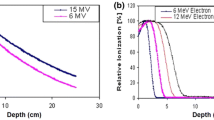Abstract
Aim
The aim of this work was to estimate the error in dose calculations, to check the agreement between the measured and calculated doses and to analyse dose discrepancies in the group of patients undergoing total body irradiation.
Patients and Methods
A combination of lateral and anterior-posterior fields was used in 8 fractions and on 4 consecutive days. Doses were preliminarily calculated and then measured in vivo by thermoluminescent, semiconductor and ionization dosimeters attached to the body in 10 representative transverse cross-sections. Calculations and measurements were carried out for the beam at the body entry and exit. The error in dose calculations was estimated for each reference point. Dose deviations between calculations and measurements were analysed using the Student’s t-test.
Results
The error in preliminary dose calculations ranged from 3% to 15% (Table 1). Standard deviations of the measurements and percent deviations from the calculations exceeded 10% only for the lung and neck exits (Table 3) Average thermoluminescent readings were 6% higher than the corresponding semiconductor readings. The measured doses fitted the calculated values within the limit of error, except for the lung, head and neck exits for the whole group, depending on the type of fields used (Table 4).
Zusammenfassung
Ziel
Das Ziel dieser Arbeit war, bei Ganzkörperbestrahlungen den Fehler in der Dosisberechnung abzuschätzen, die Übereinstimmung zwischen berechneten und gemessenen Dosiswerten zu überprüfen und die sich ergebenden Dosisabweichungen zu analysieren.
Patienten und Methoden
Die Ganzkörperbestrahlung erfolgte in acht Fraktionen an vier aufeinanderfolgenden Tagen in einer Kombination aus seitlichen und frontalen Gegenfeldern. Die Eintritts- und Austrittsdosis wurde an zehn repräsentativen Körperquerschnitten vor der Bestrahlung berechnet und anschließend in vivo mit Thermolumineszenzund Halbleiterdetektoren sowie mit Ionisationskammern gemessen. Die Unsicherheit der Dosisberechnung wurde für jeden Meßpunkt abgeschätzt. Die Abweichungen zwischen den gemessenen und berechneten Dosiswerten wurden nach dem Student-t-Test ausgewertet.
Ergebnisse
Die Unsicherheit in der Dosisberechnung reichte von 3% bis 15% (Tabelle 1). Die aus den Messungen berechneten Standardabweichungen sowie die prozentualen Abweichungen zwischen den gemessenen und berechneten Werten überschritten 10% nur bei der Austrittsdosis im Bereich von Hals und Lunge (Tabelle 3). Im Mittel lagen die Meßwerte der Thermolumineszenzdetektoren 6% höher als die entsprechenden Werte der Halbleiterdetektoren. Die gemessenen Dosiswerte stimmten mit Ausnahme der Austrittsdosis an Kopf, Hals und Lunge mit den berechneten Werten innerhalb der abgeschätzten Fehlergrenzen überein (Tabelle 4).
Similar content being viewed by others
References
AAPM Task Group 29. The physical aspects of total- and half body photon irradiation. AAPM Report 17. New York: American Institute of Physics, 1986.
Cosset J M, Baume D, Pico J, et al. Single dose versus hyperfractionated total body irradiation before allogeneic bone marrow transplantation: a non-randomized comparative study of 54 patients at the Institute Gustave-Roussy. Radiother Oncol 1989;15:151–160.
Cosset JM, Girinski T, Maloise E, et al. Clinical basis for TBI fractionation. Radiother Oncol 1990;18: Suppl:60–68.
Gale RP, Butturini A, Bortin MM. What does total body irradiation do in bone marrow transplants for leukemia. Int J Radiat Oncol Biol Phys 1991.
Girinsky T, Briot E, Bridier A, et al. Principles of total body irradiation. Rep Practic Oncol 1997;2:33–35.
Inoue, T, Ikeda H, Yamazaki H. Role of total body irradiation as based on comparison of preparation regimens for allogeneic bone marrow transplantation for acute leukemia in first complete remission. Strahlenther Onkol 1993;169:250–255.
Kolb HJ, Gratiwohl A, Zwaan FE. Randomized study comparing busulfan and cyclophospharnide with total body irradiation with cyclophosphamide as conditioning treatment for allogeneic bone marrow transplantation patients with leukemia. Protocol of Acute Leucemia working Party. European Cooperative Group for Bone Marrow Transplantation (EBMT), 1988.
Laber B, Bogdani V, Nemet D, et al. Total body irradiation with or without lung shielding for allogeneic bone marrow transplantation. Bone Marrow Transplant 1992;9:343–347.
Malicki J, Kierzkowski J, Kosicka G, et al. Calculation and in vivo dose distribution verification in fractionated total body irradiation. Nowotwory 1995;45:39–45 (in polish).
Malicki J, Kosicka G, Kierzkowski J, et al. The analysis of effectiveness and accuracy of ionization, semiconductor and thermoluminescent detectors used in total body irradiation. J Med Phys 1996;21:10–13.
Molls M, Quast U, Schaefer UW, et al. Clinical results and the Essen Concept of TBI. Radiother Oncol 1990;18:Suppl:121–25.
Peters LJ, Withers HR, Cundiff JH, et al. Radiobiological considerations in the use of total body irradiation for bone-marrow transplantation. Radiology 1979;131:243–247.
Quast U. Physical problems of total body irradiation. Strahlenther Onkol 1986;162:233–236.
Quast U. Total body irradiation — review of treatment techniques in Europe. Radiother Oncol 1990;Suppl: 158–62.
Quast U. The dose to lung in TBI. Strahlenther Onkol 1991;167:135–157.
Rittmann KL, Meinass H, Rennicke P. Dose to lung. Proc. of a DGMP Working Group Seminar, Essen 1990.
Sánchez-Doblado F, Quast V, Arrians R, et al. Total body irradiation prior to bone marrow transplantation. EBMT, 1995.
Sánchez-Nieto B, Sánchez-Doblado F, Terrón JA. A CT-aided PC-based physical treatment planning of TBI: a method for dose calculation. Radiother Oncol 1997;42:77–85.
Vriesendorp HM. Radiobiological speculations on therapeutic total body irradiation. Critical review. Hematol Oncol 1990;10:211–221.
Wachowiak J, Bettoni C, Lange A, et al. Can busulfan replace fractionated total body irradiation as conditioning regimen for allogeneic bone marrow transplantation in children with acute lymphoblastic leukemia. Acta Haematol Pol 1995;26:377–383.
Wu DP, Milpied N, Moreau P, et al. Total body irradiation and high-dose cyclophosphamide, BCNU and VP-16 (CBV) as a new preparatory regimen for allogeneic bone marrow transplantation in patients with advanced hematologic malignancies. Bone Marrow Transplantat 1994;14:751–757.
Author information
Authors and Affiliations
Rights and permissions
About this article
Cite this article
Malicki, J. The accuracy of dose determination during total body irradiation. Strahlentherapie und Onkologie 175, 208–212 (1999). https://doi.org/10.1007/BF02742397
Received:
Accepted:
Issue Date:
DOI: https://doi.org/10.1007/BF02742397




